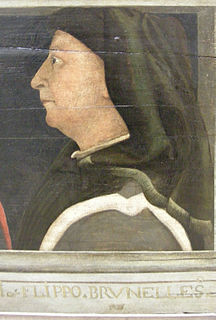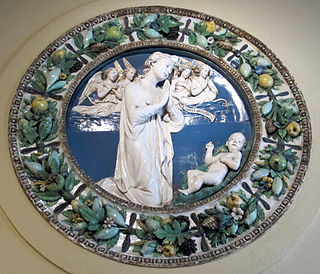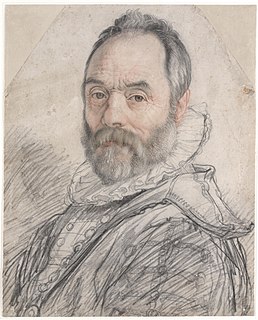Related Research Articles

Bartolomeo Ammannati was an Italian architect and sculptor, born at Settignano, near Florence. He studied under Baccio Bandinelli and Jacopo Sansovino and closely imitated the style of Michelangelo.

Florence is a city in Central-Northern Italy and the capital city of the Tuscany region. It is the most populated city in Tuscany, with 383,084 inhabitants in 2013, and over 1,520,000 in its metropolitan area.

Michelangelo di Lodovico Buonarroti Simoni, known simply as Michelangelo, was an Italian sculptor, painter, architect and poet of the High Renaissance. Born in the Republic of Florence, his work had a major influence on the development of Western art, particularly in relation to the Renaissance notions of humanism and naturalism. He is often considered a contender for the title of the archetypal Renaissance man, along with his rival and elder contemporary, Leonardo da Vinci. Given the sheer volume of surviving correspondence, sketches, and reminiscences, Michelangelo is one of the best-documented artists of the 16th century and several scholars have described Michelangelo as the most accomplished artist of his era.

Donato di Niccolò di Betto Bardi, better known as Donatello, was a Florentine sculptor of the Renaissance period. Born in Florence, he studied classical sculpture and used this to develop a complete Renaissance style in sculpture, whose periods in Rome, Padua, and Siena introduced to other parts of Italy a long and productive career. Financed by Cosimo de' Medici, Donatello's David, was the first freestanding nude male sculpture since antiquity.

Filippo Brunelleschi, considered to be a founding father of Renaissance architecture, was an Italian architect, designer, and sculptor, and is now recognized to be the first modern engineer, planner, and sole construction supervisor. In 1421, Brunelleschi became the first person to receive a patent in the Western world. He is most famous for designing the dome of the Florence Cathedral, a feat of engineering that had not been accomplished since antiquity, as well as the development of the mathematical technique of linear perspective in art which governed pictorial depictions of space until the late 19th century and influenced the rise of modern science. His accomplishments also include other architectural works, sculpture, mathematics, engineering, and ship design. His principal surviving works can be found in Florence, Italy.

Giorgio Vasari was an Italian painter, architect, engineer, writer, and historian, best known for his Lives of the Most Excellent Painters, Sculptors, and Architects, considered the ideological foundation of art-historical writing, and the basis for biographies of several Renaissance artists, including Leonardo da Vinci. Vasari designed the Tomb of Michelangelo in the Basilica of Santa Croce, Florence that was completed in 1578. Based on Vasari's text in print about Giotto's new manner of painting as a rinascita (rebirth), author Jules Michelet in his Histoire de France (1835) suggested adoption of Vasari's concept, using the term Renaissance to distinguish the cultural change. The term was adopted thereafter in historiography and still is in use today.

Bartolommeo Bandinelli, actually Bartolommeo Brandini, was a Renaissance Italian sculptor, draughtsman, and painter.

Luca della Robbia was an Italian sculptor from Florence. Della Robbia is noted for his colorful, tin-glazed terracotta statuary, a technique which he invented and passed on to his nephew Andrea della Robbia and great-nephews Giovanni della Robbia and Girolamo della Robbia. Though a leading sculptor in stone, he worked primarily in terracotta after developing his technique in the early 1440s. His large workshop produced both cheaper works cast from molds in multiple versions, and more expensive one-off individually modeled pieces.

Andrea del Verrocchio, born Andrea di Michele di Francesco de' Cioni, was a sculptor, Italian painter and goldsmith who was a master of an important workshop in Florence. He apparently became known as Verrocchio after the surname of his master, a goldsmith. Few paintings are attributed to him with certainty, but a number of important painters were trained at his workshop. His pupils included Leonardo da Vinci, Pietro Perugino and Lorenzo di Credi. His greatest importance was as a sculptor and his last work, the Equestrian statue of Bartolomeo Colleoni in Venice, is generally accepted as a masterpiece.

Giambologna — — was a Flemish sculptor based in Italy, celebrated for his marble and bronze statuary in a late Renaissance or Mannerist style.

Nanni d'Antonio di Banco was an Italian sculptor from Florence.

Antonio del Pollaiuolo, also known as Antonio di Jacopo Pollaiuolo or Antonio Pollaiuolo, was an Italian painter, sculptor, engraver, and goldsmith during the Italian Renaissance.

Arnolfo di Cambio was an Italian architect and sculptor. He designed Florence Cathedral and the sixth city wall around Florence (1284-1333), while his most important surviving work as a sculptor is the tomb of Cardinal de Braye in S. Domenico, Orvieto.

Lorenzo Bartolini was an Italian sculptor who infused his neoclassicism with a strain of sentimental piety and naturalistic detail, while he drew inspiration from the sculpture of the Florentine Renaissance rather than the overpowering influence of Antonio Canova that circumscribed his Florentine contemporaries.

Paul Maximilien Landowski was a French monument sculptor of Polish descent. His best-known work is Christ the Redeemer in Rio de Janeiro, Brazil.

Giovanni Battista (Giambattista) Foggini was an Italian sculptor active in Florence, renowned mainly for small bronze statuary.

Ardengo Soffici was an Italian writer, painter, poet, sculptor and intellectual.

Niccolò di Piero Lamberti, also known as Niccolò di Pietro Lamberti, Niccolo Aretino, Niccolò d'Arezzo and as il Pela, was an Italian sculptor and architect. Little is known about his life other than that he was married in Florence in 1392. His son, Piero di Niccolò Lamberti (1393–1435), was also a sculptor, and the two are notable for exporting the Tuscan style of sculpture to Venice, where they were active in the late 1410s and 1420s.

Augusto Rivalta was an Italian sculptor.

The Statue of Dante Alighieri is a monument of Dante Alighieri. It is located in Piazza Santa Croce, next to Basilica of Santa Croce, Florence, Italy. It was built in 1865 by Italian sculptor Enrico Pazzi.
References
- ↑ Abecedario pittorico, by Pellegrino Antonio Orlandi, Pietro Guarienti, page 337.
| Wikimedia Commons has media related to Leonardo del Tasso . |